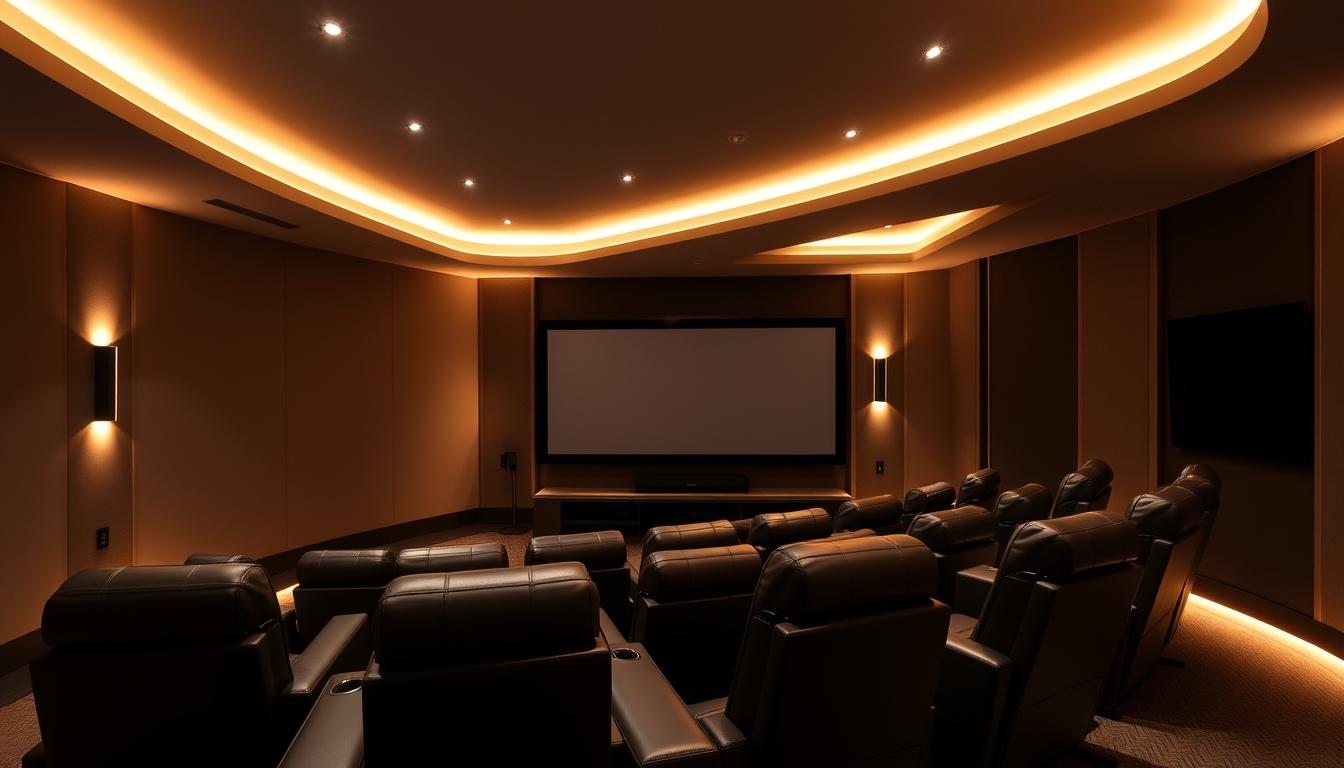78% of homeowners now prioritize smart lighting when designing entertainment spaces, according to recent smart home industry reports. This shift reflects a growing demand for environments that adapt to your preferences instantly. Imagine lights dimming automatically as your movie starts or shifting hues to match on-screen action—all without touching a switch.
Modern smart home systems turn these scenarios into everyday reality. They merge your entertainment setup with intelligent lighting control, creating synchronized experiences that elevate movie nights. Gone are cluttered remotes and manual adjustments—voice commands or smartphone taps now orchestrate your entire viewing environment.
These systems do more than set moods. They optimize energy use through motion sensors and scheduling features. Property value increases by up to 5% for homes with integrated smart technology, per real estate analysts. Your space becomes future-ready, accommodating new devices as home automation evolves.
Key Takeaways
- Automated lighting adjusts to movie scenes and viewer preferences
- Voice commands replace multiple remotes for simplified operation
- Energy-saving features reduce electricity costs over time
- Customizable presets enhance different content types (movies, sports, gaming)
- Integrated systems increase property market appeal
Overview of Smart Home Theater Integration
Modern entertainment spaces now function as living ecosystems rather than isolated setups. Unlike traditional systems, smart home integration weaves your home theater into a responsive network of devices that adapt to your lifestyle. This approach turns ordinary movie nights into curated experiences where lighting, sound, and climate adjust in real time.
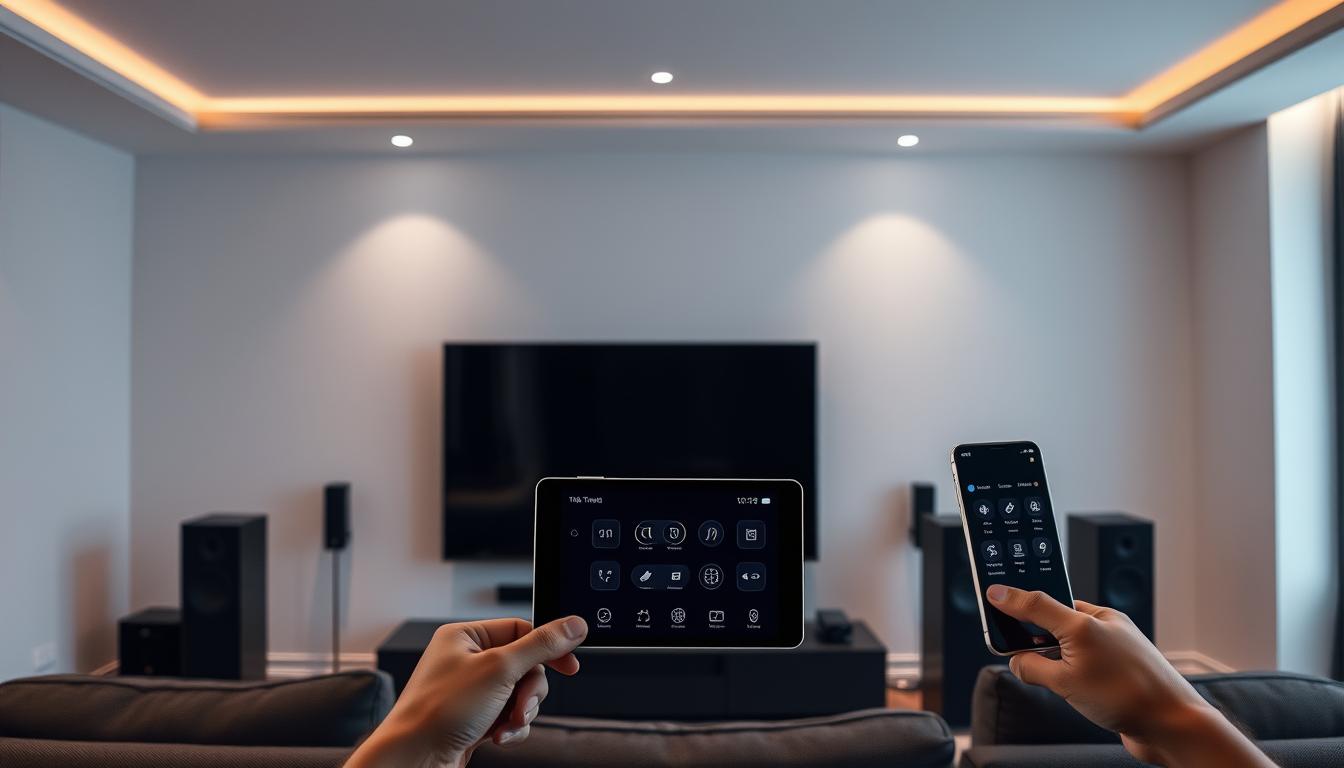
Understanding the Smart Home Concept
At its core, a smart home merges entertainment systems with automated controls. Imagine lights dimming as your projector powers on, or blinds closing when you start a film. These technology interactions happen seamlessly through central hubs or voice commands, eliminating manual adjustments.
Benefits of a Connected Home Theater
Integrated systems deliver three key advantages:
- Personalization: Create presets for gaming marathons or weekend movie sessions
- Efficiency: Motion sensors cut energy use by up to 30% in unused rooms
- Accessibility: Grandparents and kids alike control settings via simple voice prompts
Beyond convenience, connected theaters enhance security. Automated lights mimic occupancy during vacations, while synchronized cameras activate when doors open unexpectedly. For those refining their perfect lighting setup, smart bulbs adjust color temperatures to reduce eye strain during 3-hour movie binges.
Real estate experts note these upgrades boost resale value by making spaces feel cutting-edge. Your home theater becomes more than a room—it evolves into an intelligent extension of your daily life.
Smart Lighting Control Fundamentals for Home Theaters
Lighting forms the backbone of immersive entertainment systems. Modern solutions transform ordinary rooms into dynamic spaces that respond to your needs. Through strategic automation, these setups eliminate distractions while enhancing visual clarity.
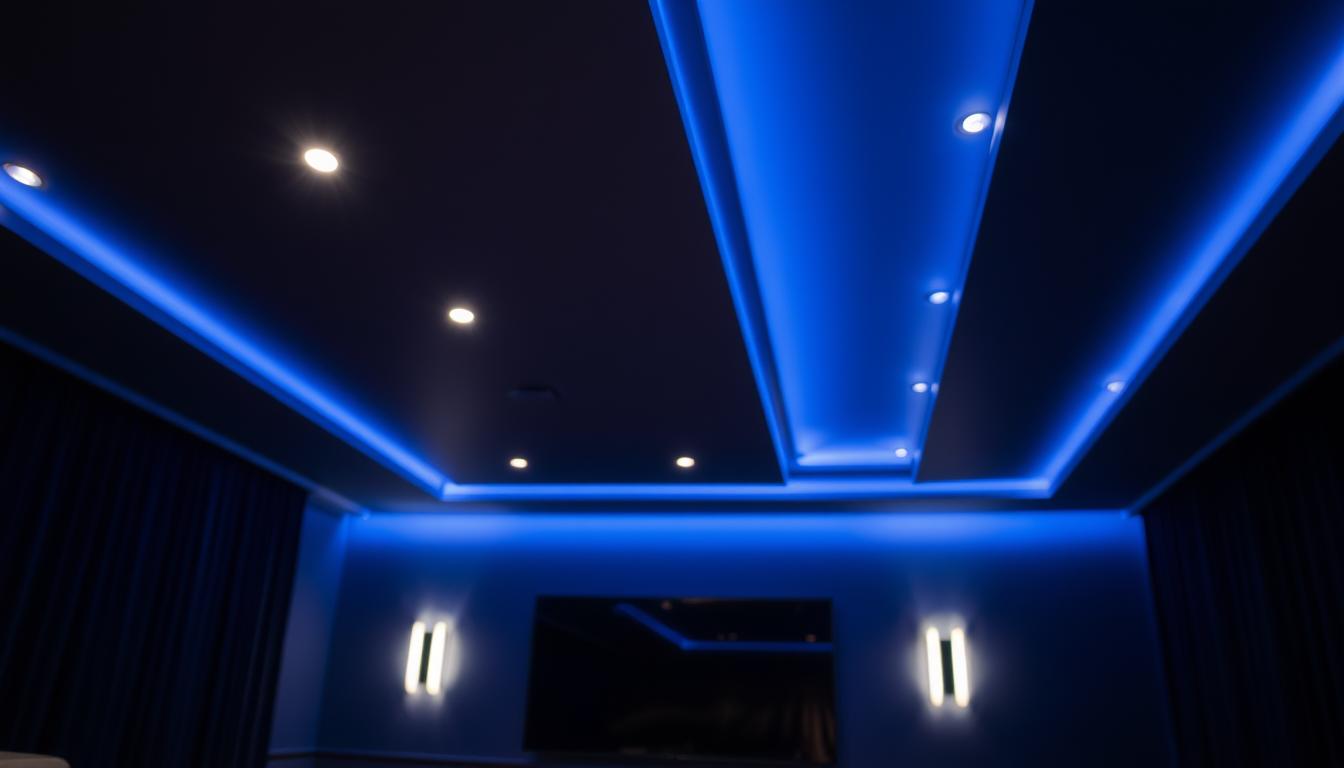
Automated Lighting Benefits
Smart home systems excel at energy management. Motion detectors cut power when spaces sit empty, reducing bills by 15-20% annually. Dimmable fixtures create gradual transitions—bright for snacks, soft for previews, dark for feature films.
Occupancy sensors offer dual benefits. They prevent accidental left-on lights while maintaining safety. Path lighting activates when you move toward exits during movies. This balance keeps focus on-screen without tripping hazards.
| Feature | Smart Bulbs | Traditional Bulbs |
|---|---|---|
| Dimming Capability | Yes | Limited |
| Color Options | 16 million+ | Single |
| Energy Use | 8-10 watts | 40-60 watts |
| Control Methods | Voice/app/schedule | Switch only |
Integrating Smart Shades and Color-Changing Bulbs
Motorized blinds sync with your schedule. They drop at movie times, blocking glare without manual adjustments. Combined with adaptive lighting, they maintain consistent brightness levels day or night.
RGB bulbs add emotional depth. Imagine crimson hues during thrillers or oceanic blues for documentaries. Popular apps like Philips Hue let you match colors to content genres. Voice commands toggle between presets—no fumbling with remotes.
These devices work together seamlessly. Lights dim as shades lower, triggered by play buttons on streaming platforms. The result? Cinematic immersion achieved through coordinated control.
Enhancing Your Home Theater Experience with Smart Audio and Visual Controls
Your entertainment space transforms into a sensory command center when audio and visual elements work in harmony. Advanced systems now let you sculpt every sonic detail and pixel through intuitive interfaces. This precision turns ordinary nights into cinematic events where your preferences dictate the action.

Optimizing Audio Performance
Modern sound systems adapt like skilled musicians. Dedicated apps let you tweak surround configurations for explosions or dialogue clarity. Create profiles for sports broadcasts versus orchestral scores—your receiver remembers each setting.
Self-calibrating tech analyzes room dimensions automatically. Speakers adjust output based on seating positions, ensuring balanced sound whether you’re center-row or lounging sideways.
Visual Adjustments for Immersive Viewing
Screens now react to environmental changes. Brightness levels shift as daylight fades, maintaining optimal contrast. Streaming platforms trigger preset modes—vivid hues for animations, natural tones for documentaries.
Late-night viewing activates eye-comfort filters. These subtle tweaks happen through light sensors, preserving picture quality without manual control.
Voice Assistant Integration
Voice assistants become your backstage crew. Whisper “lower volume during credits” or “switch to gaming mode” without reaching for remotes. Commands sync across systems, dimming lights as screens power on.
Multi-room setups let music follow you kitchen-to-couch. Say “play soundtrack in theater” to continue melodies where you left off. This seamless interaction keeps your focus on the story, not the settings.
Selecting the Right Smart Home System and Devices
Choosing entertainment technology that grows with your needs demands strategic planning. Three critical factors determine success: seamless integration, effortless operation, and future-ready design.
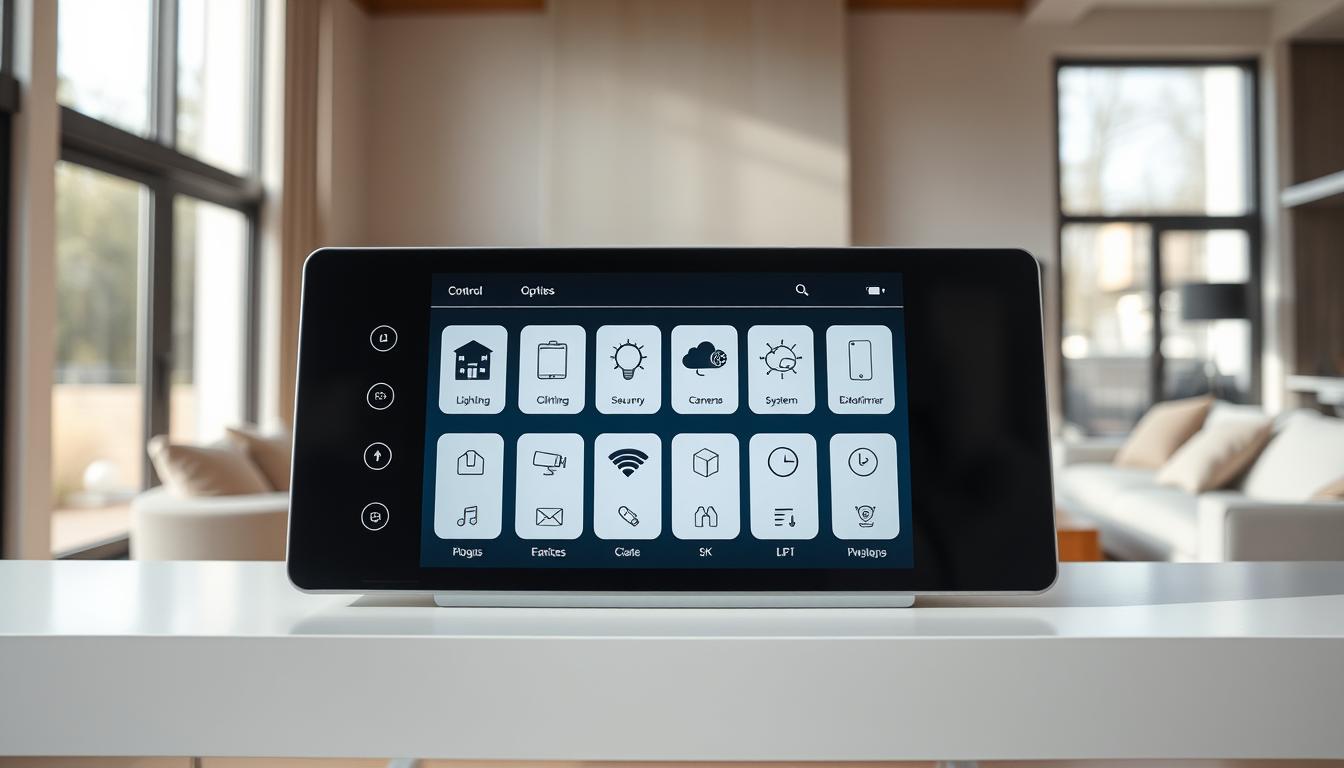
Compatibility and User-Friendliness
Your smart home system must speak every language your devices use. Check protocols like Zigbee or Z-Wave for universal communication. Projectors from 2018 should sync with 2024 lighting controls without adapters.
Test control interfaces personally. Can grandparents activate movie mode in two taps? Systems like Apple HomeKit use visual room maps, while Amazon Alexa relies on voice-first navigation.
| Platform | Device Support | Voice Control | Update Frequency |
|---|---|---|---|
| Google Home | 50,000+ products | Natural language | Bi-weekly |
| Apple Home | HomeKit-certified only | Siri shortcuts | Quarterly |
| Amazon Alexa | 140,000+ skills | Multi-room audio | Monthly |
Expansion potential matters most. Leading brands like Lutron and Control4 offer modular setups. Start with basic lighting controls, then add motorized shades or HVAC integration later.
Prioritize companies with proven update histories. Systems receiving quarterly firmware upgrades outlast those abandoned after launch. Your right smart home choice today becomes tomorrow’s foundation for new innovations.
Designing Smart Automation Scenes for Home Theaters
Your entertainment space becomes a shape-shifting environment through automation scenes. These pre-programmed sequences activate multiple systems through single commands, transforming ordinary evenings into curated experiences.
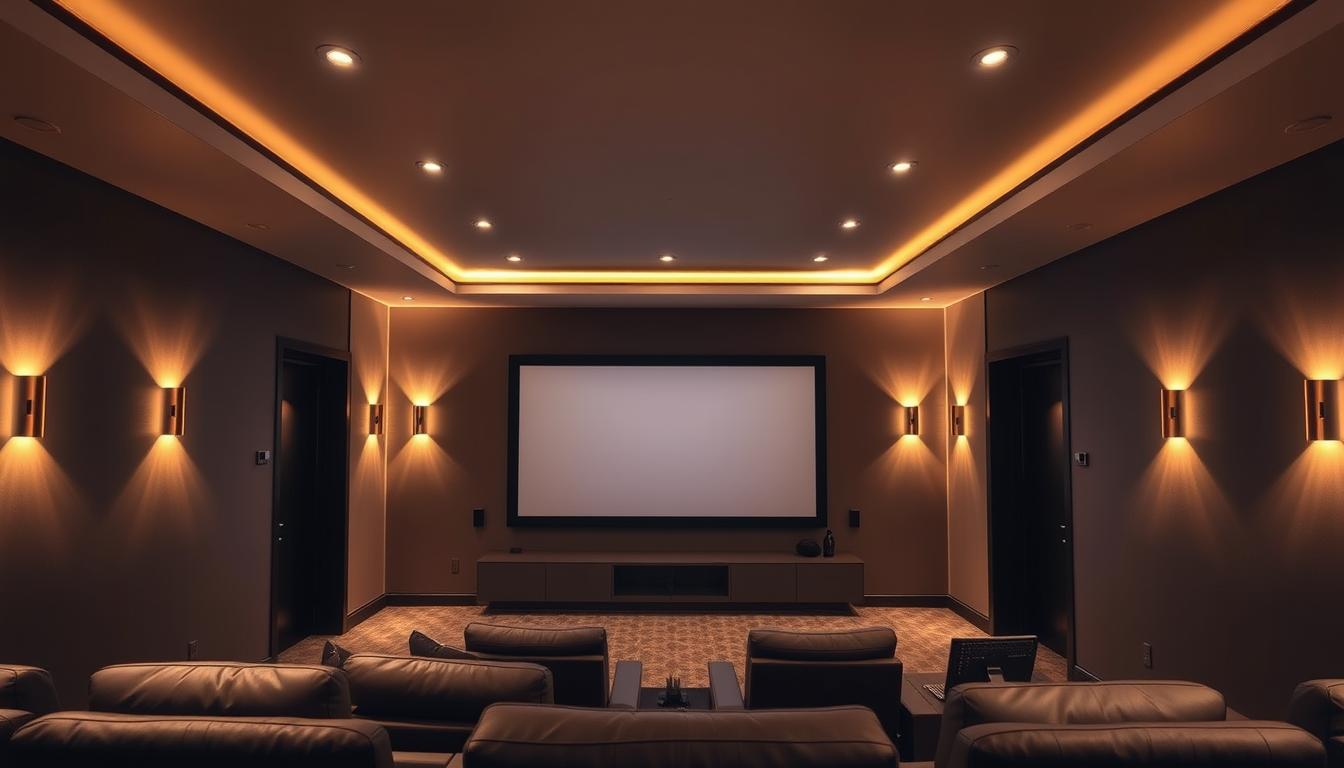
Creating Preset Scenes for Different Activities
Voice commands like “Action movie mode” trigger cascading adjustments. Lights dim to 20%, surround sound boosts bass frequencies, and your projector screen unfurls automatically. For gaming sessions, scenes maintain brighter lighting to reduce eye strain while enhancing directional audio cues.
“Automation turns viewers into directors—every command reshapes your environment instantly.”
Consider these popular scene configurations:
| Activity | Lighting Level | Temperature | Audio Profile |
|---|---|---|---|
| Movie Night | 10% dimmed | 68°F | Dolby Atmos |
| Sports Party | 75% bright | 65°F | Stadium Mode |
| Romantic Evening | 40% warm hue | 72°F | Background Jazz |
Utilizing Mobile Apps for Seamless Control
Leading apps like Savant and Crestron let you build scenes through drag-and-drop interfaces. Create “Intermission” modes that brighten lights to 50% and pause media playback with one tap. During setup, prioritize:
- Scene duration controls
- Manual override options
- Device status indicators
Geofencing features activate scenes as you approach home. Your theater preps itself when you cross a 5-mile radius—no more waiting for systems to boot up.
How to Integrate a Home Theater with Smart Lighting Controls
Seamlessly merging your entertainment system with intelligent illumination requires precise execution. Start by mapping your space’s electrical layout and device locations. Identify where ambient lighting enhances viewing without causing glare or reflections on screens.
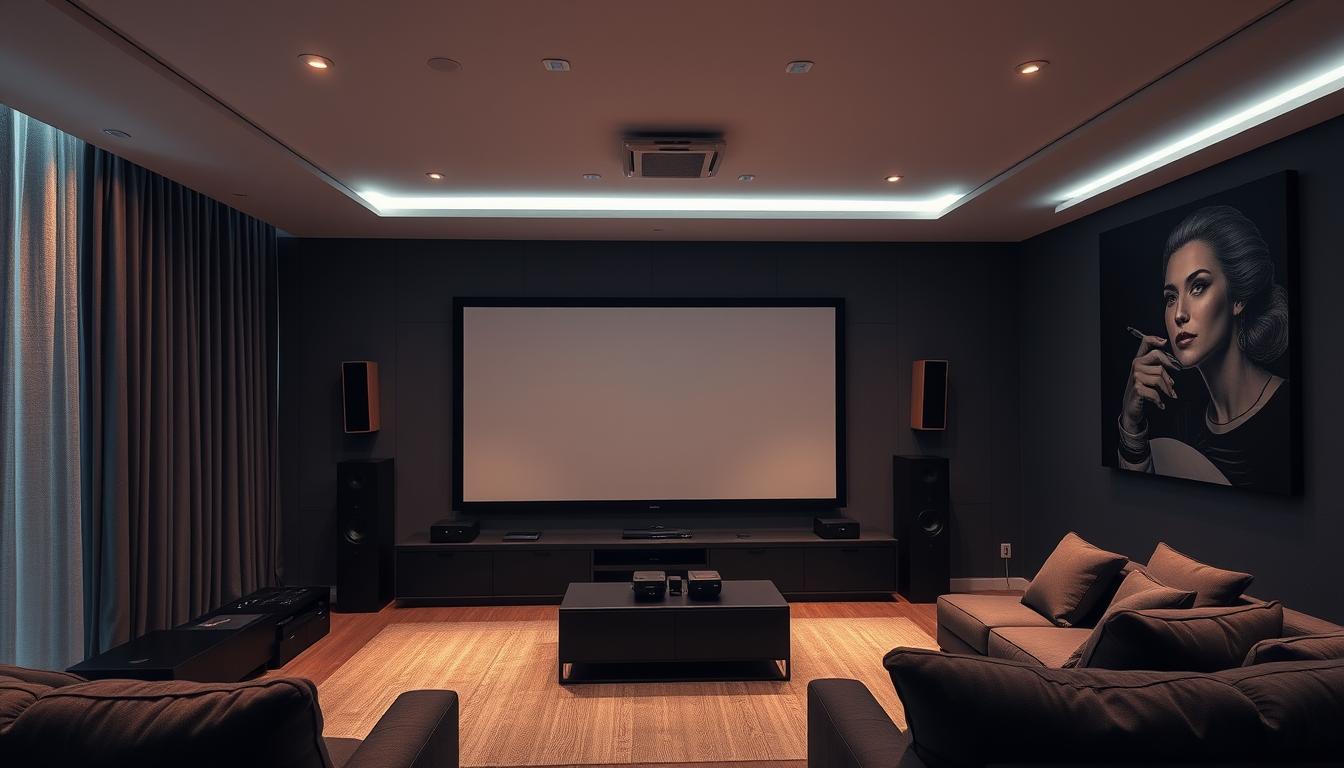
Step-by-Step Integration Process
Begin with a full audit of your current equipment. Check power sources near seating areas and screen walls. Choose a hub that supports both Zigbee and Wi-Fi protocols for maximum device flexibility.
Install smart switches during off-peak viewing hours to avoid disruptions. For complex setups involving control home systems, hire certified technicians. They’ll handle wiring while preserving existing streaming device connections.
Test each light zone separately before full activation. Verify voice commands adjust brightness during playback. Create scene triggers that activate when your receiver powers on.
Ensuring Compatibility with Existing Devices
Update all firmware through manufacturer apps first. Older projectors might need IR blasters to communicate with modern hubs. Use compatibility charts from brands like Lutron to match bulbs with your router’s frequency.
Conduct signal strength tests in your theater space. Thick walls may require Wi-Fi extenders for reliable system communication. Document device IP addresses for quick troubleshooting.
Establish fail-safes like manual override switches. These maintain basic functionality during network outages. Schedule monthly sync checks to prevent compatibility drift between updates.
Overcoming Smart Home Integration Challenges
Reliable connectivity and data protection form the foundation of modern entertainment spaces. Network stability ensures synchronized lighting and audio respond instantly, while robust security smart protocols keep your personal information safe. Let’s explore solutions for maintaining seamless operation.
Managing Wi-Fi and Network Reliability
Dead zones ruin movie nights. Mesh networks eliminate weak signals by placing multiple nodes around your theater. Dedicate 5GHz bandwidth to streaming devices for buffer-free 4K playback.
Consider backup power solutions. Uninterruptible power supplies keep routers online during outages. Pair these with local control hubs that function without internet access.
| Solution | Mesh Network | Traditional Router |
|---|---|---|
| Coverage Area | 5,000 sq ft | 1,500 sq ft |
| Simultaneous Devices | 75+ | 25 |
| Security Protocols | WPA3 Encryption | WPA2 |
| Failover Support | Yes | No |
Addressing Privacy and Security Concerns
Your home security system should defend against digital and physical threats. Enable two-factor authentication on all smart devices. Schedule automatic firmware updates every Thursday night when systems are idle.
“Network segmentation acts like a vault—smart bulbs operate separately from door locks and cameras.”
Implement these protective measures:
- Create guest networks for visitor device access
- Disable microphone permissions on voice assistants post-setup
- Use VPNs for remote system monitoring
Monthly security audits identify vulnerabilities. Replace default passwords with 12-character phrases mixing symbols and numbers. Your smart home security becomes impenetrable through consistent vigilance.
Conclusion
Your entertainment space evolves into a responsive partner through smart home theater integration. Systems now anticipate needs—dimming lights during tense scenes or adjusting temperatures for marathon viewing sessions. These upgrades transform ordinary nights into curated experiences where technology serves silently.
Modern home theater system setups deliver tangible benefits smart home enthusiasts appreciate. Energy-efficient lighting cuts costs, while voice assistants simplify complex commands. Your space gains market appeal, with realtors noting tech-enhanced rooms attract premium offers.
Future-proof designs ensure seamless control home theater elements as new innovations emerge. Modular platforms let you add motorized shades or advanced sound calibration later. Regular firmware updates keep security tight and performance sharp.
These smart home upgrades do more than dazzle guests—they redefine daily living. Your theater becomes a dynamic extension of personal style, blending cinematic thrills with practical automation. It’s not just about better movies—it’s about crafting spaces that adapt to life’s every scene.
FAQ
Can smart lighting controls work with existing home theater systems?
Yes. Most smart lighting brands like Philips Hue, Lutron, and LIFX integrate with popular home theater setups. Check compatibility with your audio-visual devices, such as Sonos sound systems or Samsung TVs, using apps like SmartThings or Apple HomeKit for seamless automation.
What are the benefits of adding voice assistants to a smart home theater?
Voice assistants like Amazon Alexa or Google Assistant let you adjust lighting, audio levels, and streaming content hands-free. For example, say “Alexa, dim the lights” to set the mood without leaving your seat, enhancing convenience during movie nights.
How do smart shades improve a home theater experience?
Motorized shades from brands like Serena by Lutron or IKEA’s FYRTUR block glare and sync with lighting scenes. Pair them with color-changing bulbs to create immersive environments—like darkening the room automatically when you press “play” on your projector.
Are there security risks when connecting smart devices to a home theater?
Smart home systems can face vulnerabilities if not secured. Use encrypted networks, enable two-factor authentication for apps like Google Home, and update firmware regularly. Brands like Ring or Arlo offer secure cameras that integrate without compromising privacy.
What factors ensure user-friendly smart home automation?
Prioritize systems with intuitive apps, such as Control4 or Crestron, which centralize controls. Ensure devices like Nanoleaf lights or Bose sound systems are compatible with your chosen platform to avoid complex setups. Test preset scenes for smooth transitions.
Can Wi-Fi reliability affect smart home theater performance?
Weak Wi-Fi may disrupt automation scenes or voice commands. Use mesh networks like eero or TP-Link Deco to boost coverage. For critical devices like Denon receivers, consider wired Ethernet connections to minimize lag during 4K streaming.
Do smart home upgrades require rewiring a room?
Most modern systems use wireless protocols like Zigbee or Z-Wave, eliminating rewiring. Philips Hue bulbs screw into existing fixtures, while smart plugs from Wemo adapt outlets. For advanced setups, consult an installer to integrate wired components discreetly.
